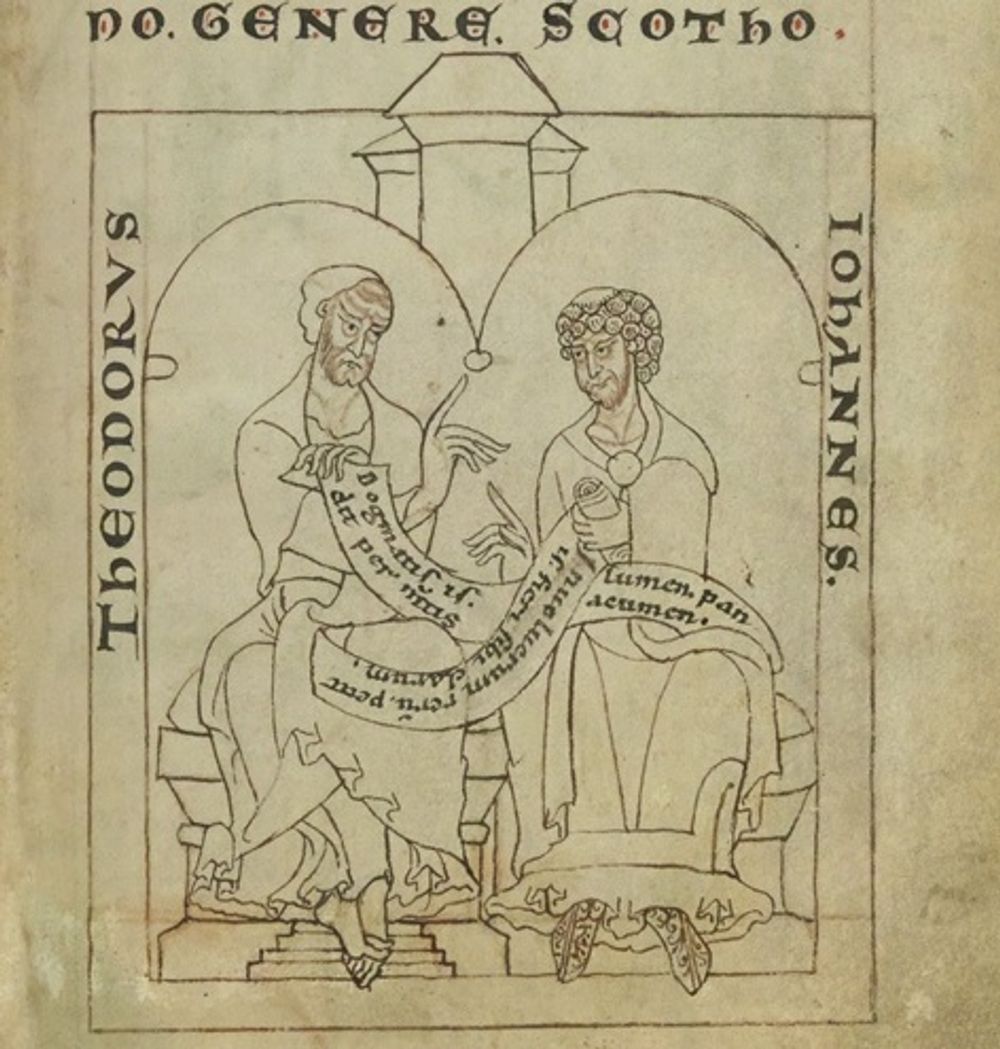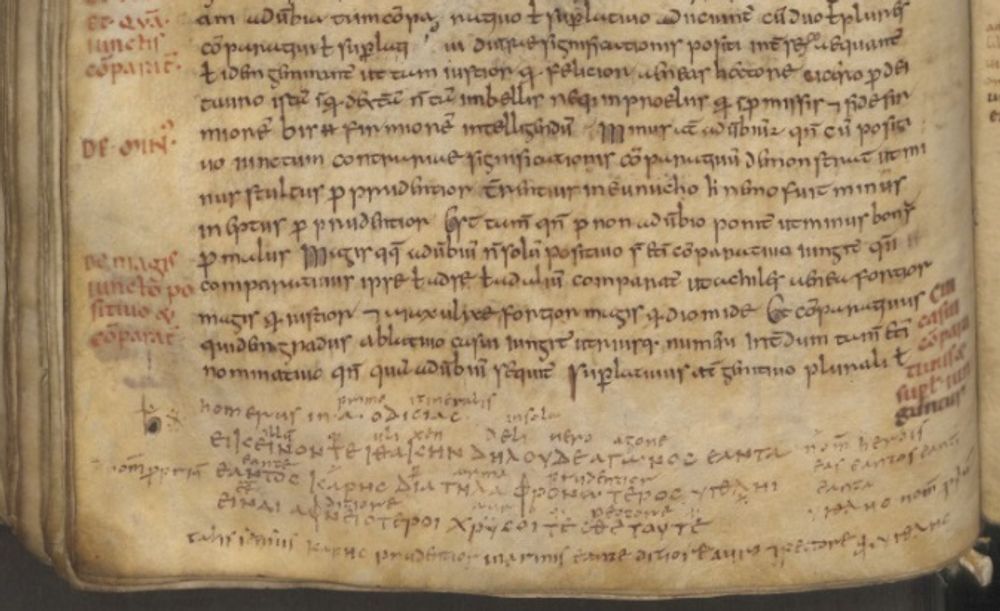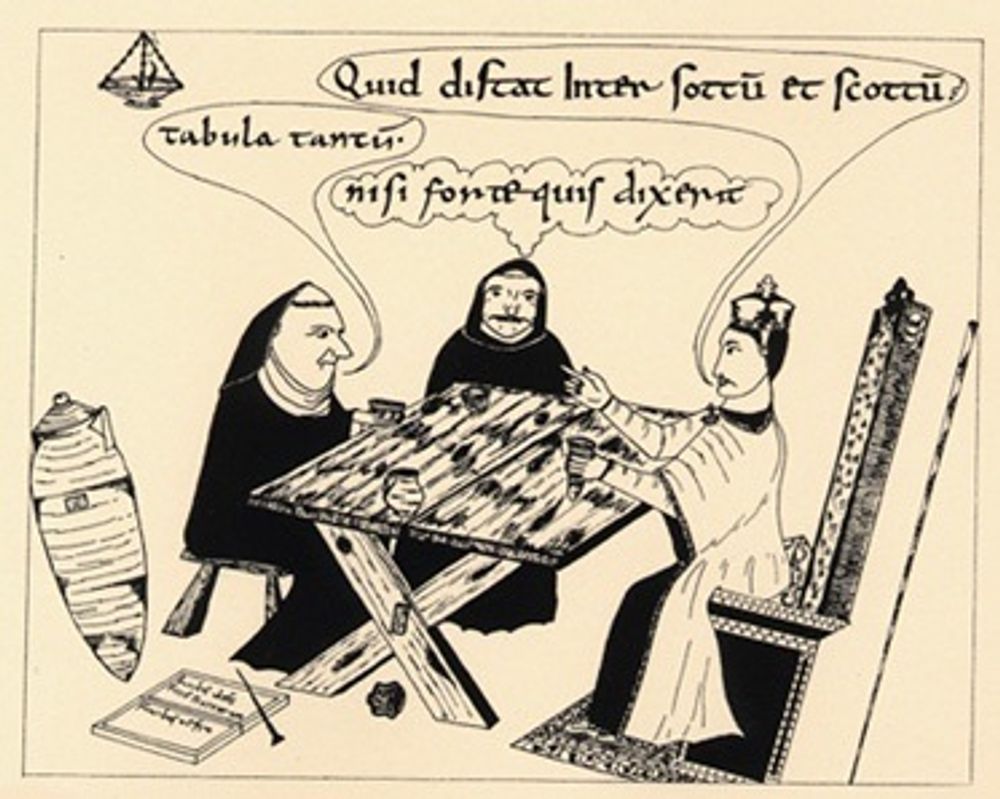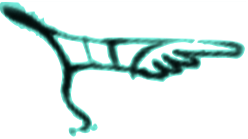John Scottus and his assistant
An Irish scholar at the Carolingian court1
John Scottus was a peculiar figure in ninth-century intellectual life. It is not sure whether he was a monk, and he was certainly not an abbot or bishop. He was educated in Ireland (hence ‘Scottus’ and ‘Eriugena’) and came to the court of Charles the Bald around 845 as head of his Palace School, just as Alcuin had been in the time of Charlemagne. He had controversial and unique ideas and opinions, which often went against the grain of the majority. He was involved in several theological debates in his time.
An imaginary portrait of John Scottus is found in manuscript Paris, BnF, Lat. 6734, fol. 3r, a copy of in Honorius of Autun’s Clavis physicae. In this portrait John Scottus discusses his most famous work, Periphyseon (On the Division of Nature, a theological treatise about the creation of the world) with ‘Abbot Theodorus’. Theodorus holds a banner with the text: “He (that is John Scottus) reveals the light of dogma by the sharpness of his mind”, and John Scottus holds a banner saying: “He (that is Theodorus) seeks to make hidden things clarify themselves.”

https://gallica.bnf.fr/ark:/12148/btv1b10023855n
Periphyseon (On the Division of Nature) is a dialogue between a master and a pupil about the four divisions of nature: that which creates and is not created; that which is created and creates; that which is created and does not create; that which is neither created nor creates. The method of reasoning is the syllogism: a basic model for logical reasoning. Here we see the model simplified and captured in opposites (contrariae) by Honorius of Autun in the twelfth century, in his Clavis physicae.


https://gallica.bnf.fr/ark:/12148/btv1b10023855n
John Scottus had a great interest in anything Greek. In manuscripts we recognize his presence by notes annotating and translating Greek passages. In manuscript Leiden, UB, BPL 67, a copy of Priscian’s Institutiones grammaticae, we see his hand in numerous notes adding and explaining Greek. On fol. 32v, for example, he added in his own hand (we know his autograph) a Greek passage from Homerus’ Odyssey and provided a Latin translation above the Greek words.

http://hdl.handle.net/1887.1/item:1603880
The assistant ‘Nisifortinus’
John Scottus’ hand in manuscripts is often accompanied by a second hand, which is similar but not quite the same. It has been argued that this hand in the hand of his close assistant, who worked for him and with him. In modern scholarship he was given the nickname Nisifortinus, “The one of ‘If not perhaps’…”. Whereas John was not afraid to take bold and controversial positions, his assistant worked hard to soften his statements and make them acceptable.
This is a cartoon made by Randall Rosenfeld, which illustrates an anecdote reported (and perhaps also invented?) by William of Malmesbury (†1143). King Charles the Bald and John Scottus were seated at the same table, and the King said: “What separates a Sot (a drunkard) from a Scot?” To which John answered: “Only a table”, suggesting that the King himself is the drunkard. And ‘Nisifortinus’ softens the insult with: “Nisi forte quis dixerit ...”, “Unless, perhaps, anyone shall say that...”

http://www.pims.ca/research/johannes-scottus-eriugena-periphyseon
Just as for John Scottus himself, we are in the rare circumstance that we know the handwriting of ‘Nisifortinus’. The two operated together in several manuscripts, the master adding corrections and notes, the student copying the master’s comments. In this manuscript with the text of Martianus Capella’s On the marriage of Mercury and Philology, Leiden, UB, BPL 88, we find ‘Nisifortinus’ making notes. The philosophical language of John Scottus and his Periphyseon is clearly recognizable: the gloss says, roughly translated, that ‘pure thinking’ is the only way to reach full understanding of the concept of number. The preoccupation with ancient Greek philosophy is also clear: we see Greek words and Greek names such as Theophrastus and Pythagoras.

http://hdl.handle.net/1887.1/item:2028417
Sources used for this contribution:
- John J. Contreni, “The early career and formation of John Scottus, in Learning and Culture in Carolingian Europe (Variorum Collected Studies Series, CS 974), VI, Farnham, Burlington, 2011.
- Édouard Jeauneau and Paul E. Dutton, The autograph of Eriugena (Corpus Christianorum, Medieval Latin Series, Autographa Medii Aevi 3), Turnhout: Brepols, 1996
- Paul E. Dutton and Anneli Luhtala, “Eriugena In Priscianum”, Mediaeval Studies 56 (1994), 153-163
- J. Peter Gumbert, “The Irish Priscian in Leiden”, Quaerendo 27.4 (1997), 280–299
- Édouard Jeauneau, “ ‘Nisifortinus’: le disciple qui corrige le mâitre”, in Poetry and Philosophy in the Middle Ages. A Festschrift for Peter Dronke, ed. J. Marenbon (Mittellateinische Studien und Texte 29), Brill, 2001, 113-129
- Research webpage “Johannes Scottus Eriugena: Periphyseon”, at the Pontifical Institute of Medieval Studies in Toronto, Canada: http://www.pims.ca/research/johannes-scottus-eriugena-periphyseon
Contribution by Mariken Teeuwen.
Cite as, Mariken Teeuwen, “John Scottus and his assistant”, The art of reasoning in medieval manuscripts (Dec 2020), https://art-of-reasoning.huygens.knaw.nl/john-scot. ↑


 Next Read:
Next Read: